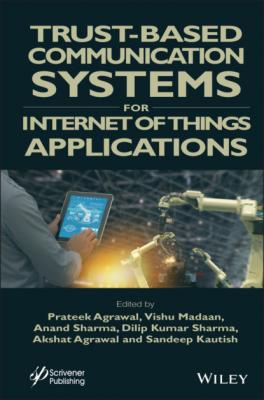ТОП просматриваемых книг сайта:
Trust-Based Communication Systems for Internet of Things Applications. Группа авторов
Читать онлайн.Название Trust-Based Communication Systems for Internet of Things Applications
Год выпуска 0
isbn 9781119896722
Автор произведения Группа авторов
Жанр Отраслевые издания
Издательство John Wiley & Sons Limited
8 viii. Industrial ControlIoT helps to make well-ordered structures and architectures of systems that are important, logical, and scalable. The main objective is to generate cooperative communications and interactions from the input or output of the manufacturing sector, including actuators, robots, analyzers, etc., to improve flexibility and improve efficiency. Industrial automation has leveraged commercial technology in external areas using IoT [20].Figure 1.9 Digital health.
9 ix. Smart FarmingFarmers would be able to decrease waste and increase production with the use of IoT. With the aid of censors, this device will allow soil and crop monitoring [21–23]. The farmers would also be able to track the conditions of the field from anywhere this is described in Figure 1.10.Figure 1.11 shows the overall applications of IoT.Figure 1.10 Smart farming.Figure 1.11 IoT application areas in 2020.
1.5 IoT Security and Protection Concerns
Despite the fact that IoT is quickly developing, it actually faces security and protection issues the complete issue are described in Figure 1.12.
Security Risks
IoT devices are connected to our laptop or PC. Lack of security builds the danger of our own information leaking while the data is collected and transmitted to the IoT device.
IoT devices are connected with a consumer network. This network is also connected with different systems. So, if the IoT device contains any security vulnerabilities, it very well may be harmful to the consumer’s network [24–29].
Sometimes unapproved individuals may exploit security vulnerabilities to create risks to physical safety.
Figure 1.12 Security challenges of IoT.
Privacy Risks
In IoT, devices are interconnected with different hardware and software, so there are probabilities of sensitive information leaking.
All the devices are transmitting the user’s personal information such as name, address, date of birth, health card information, credit card details, and much more without encryption [30–33].
Despite the fact that there are security and protection worries with IoT, it adds esteems to our lives by permitting us to deal with our day by day routine tasks distantly and consequently and all the more critically, it is a distinct advantage for enterprises.
1.6 IoT Security
1 i) Data Integrity and Validation Approval in IoT: Messages ought to be unrestricted and seen by the intended.
2 ii) Security and Data Privacy: Behaviour of client while he was associated with IoT network is collected to guarantee that he was a routing user or another person [34–37].
3 (iii) Android Platform: Most of the mobile devices available today are Android platform based. Subsequently, an ever increasing number of smart devices and smart applications are created to interface with these devices.
1.7 Conclusion
This article discusses the role and increasing growth of IoT. Further, it talks about the various IoT enabled technologies and highlights several application areas of IoT. IoT is a technology that simplifies and continues to make life simpler. Via a widespread, regionally intelligent network of smart devices, IoT has the ability to expand and improve key services in transport, logistics, defense, utilities, education, healthcare, and other fields, while providing a new environment for application growth.
References
1. M. H. Miraz, M. Ali, P. S. Excell, and R. Picking, “A Review on Internet of Things (IoT), Internet of Everything (IoE) and Internet of Nano Things (IoNT)”, in 2015 Internet Technologies and Applications (ITA), pp. 219–224, Sep. 2015, DOI: 10.1109/ITechA.2015.7317398.
2. P. J. Ryan and R. B. Watson, “Research Challenges for the Internet of Things: What Role Can OR Play?,” Systems, vol. 5, no. 1, pp. 1–34, 2017.
3. M. Miraz, M. Ali, P. Excell, and R. Picking, “Internet of Nano-Things, Things and Everything: Future Growth Trends”, Future Internet, vol. 10, no. 8, p. 68, 2018, DOI: 10.3390/fi10080068.
4. E. Borgia, D. G. Gomes, B. Lagesse, R. Lea, and D. Puccinelli, “Special issue on “Internet of Things: Research challenges and Solutions”.,” Computer Communications, vol. 89, no. 90, pp. 1–4, 2016.
5. K. K. Patel, S. M. Patel, et al., “Internet of things IOT: definition, characteristics, architecture, enabling technologies, application future challenges,” International journal of engineering science and computing, vol. 6, no. 5, pp. 6122–6131, 2016.
6. S. V. Zanjal and G. R. Talmale, “Medicine reminder and monitoring system for secure health using IOT,” Procedia Computer Science, vol. 78, pp. 471–476, 2016.
7. R. Jain, “A Congestion Control System Based on VANET for Small Length Roads”, Annals of Emerging Technologies in Computing (AETiC), vol. 2, no. 1, pp. 17–21, 2018, DOI: 10.33166/AETiC.2018.01.003.
8. S. Soomro, M. H. Miraz, A. Prasanth, M. Abdullah, “Artificial Intelligence Enabled IoT: Traffic Congestion Reduction in Smart Cities,” IET 2018 Smart Cities Symposium, pp. 81–86, 2018, DOI: 10.1049/cp.2018.1381.
9. Mahmud, S. H., Assan, L. and Islam, R. 2018. “Potentials of Internet of Things (IoT) in Malaysian Construction Industry”, Annals of Emerging Technologies in Computing (AETiC), Print ISSN: 2516-0281, Online ISSN: 2516-029X, pp. 44–52, Vol. 2, No. 1, International Association of Educators and Researchers (IAER), DOI: 10.33166/AETiC.2018.04.004.
10. Mano, Y., Faical B. S., Nakamura L., Gomes, P. G. Libralon, R. Meneguete, G. Filho, G. Giancristofaro, G. Pessin, B. Krishnamachari, and Jo Ueyama. 2015. Exploiting IoT technologies for enhancing Health Smart Homes through patient identification and emotion recognition. Computer Communications, 89.90, (178-190). DOI: 10.1016/j.comcom.2016.03.010.
11. A. Zanella, N. Bui, A. Castellani, L. Vangelista, and M. Zorzi, “Internet of Things for smart cities,’’ IEEE Internet Things J., vol. 1, no. 1, pp. 22–32, Feb. 2014.
12. L. Atzori, A. Iera, and G. Morabito, “The Internet of Things:

